Here is another eBay XFX $9 special video card  with more blown Sacon FZ capacitors. This time, a GeForce 9600 GSO model PV-T960-SDFH V1.4, based on the G92 GPU core (96 shaders, 192-bit 768 MB of DDR2 RAM).
with more blown Sacon FZ capacitors. This time, a GeForce 9600 GSO model PV-T960-SDFH V1.4, based on the G92 GPU core (96 shaders, 192-bit 768 MB of DDR2 RAM).
Overview front and back:
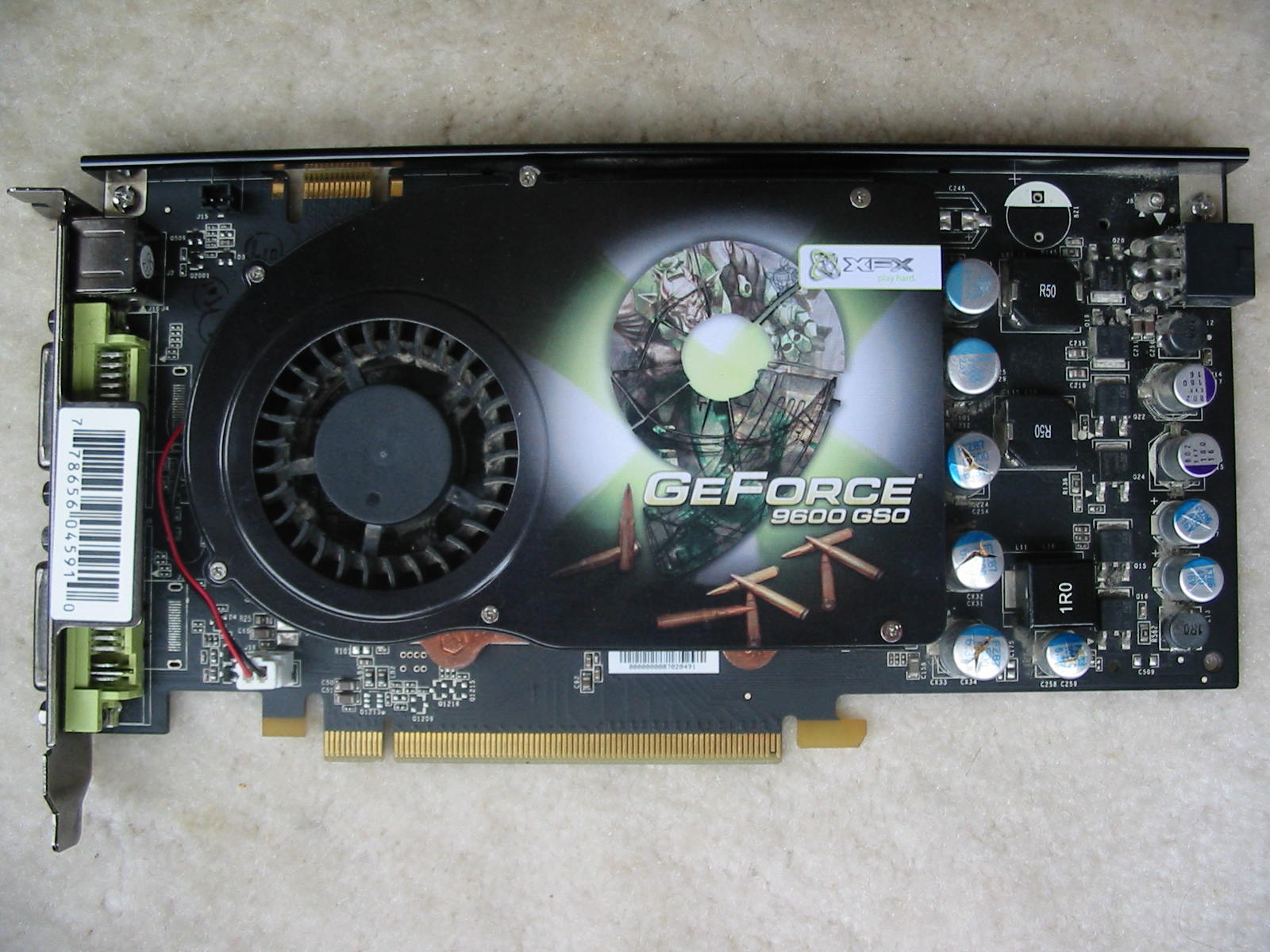
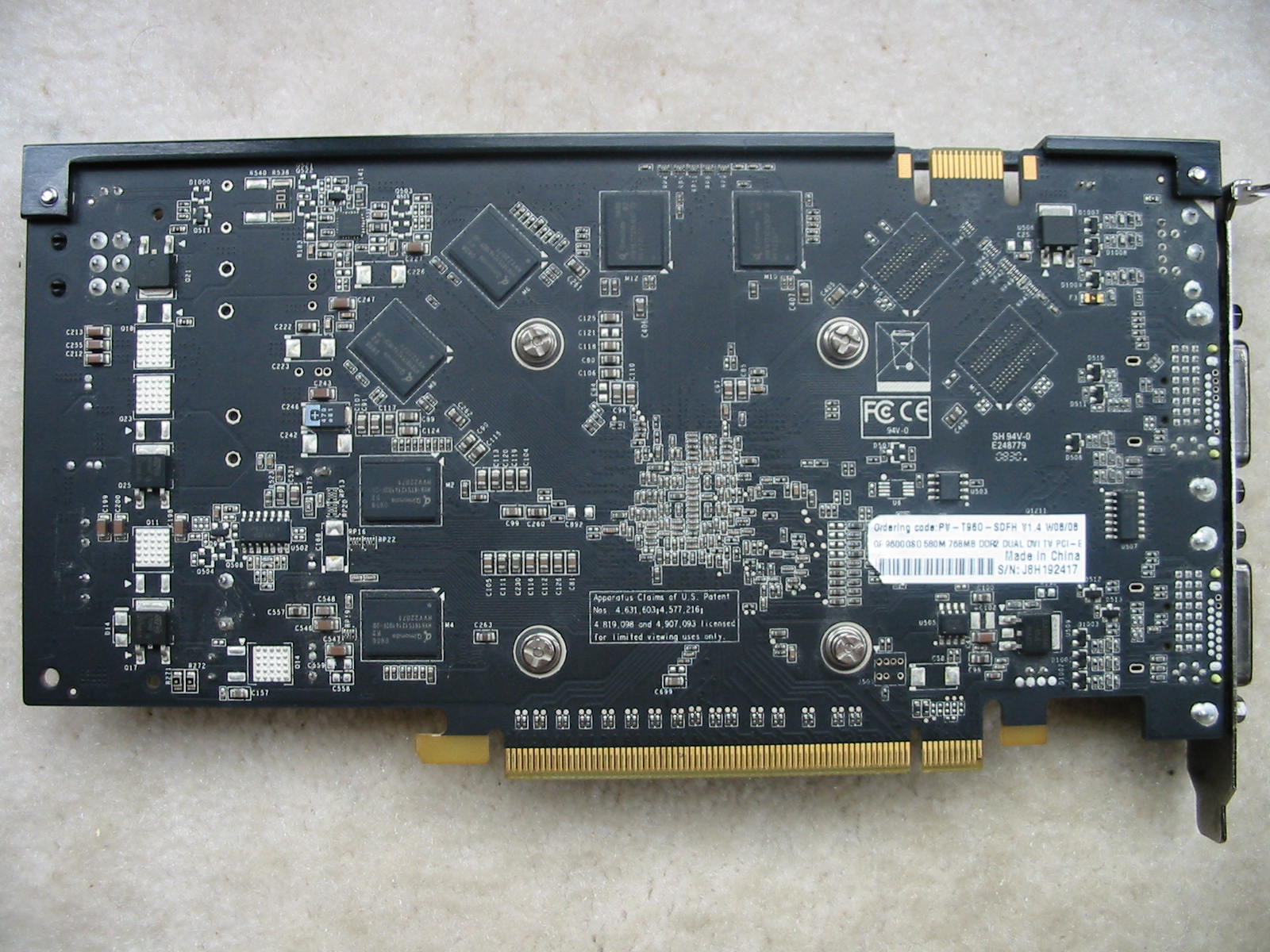
Label:
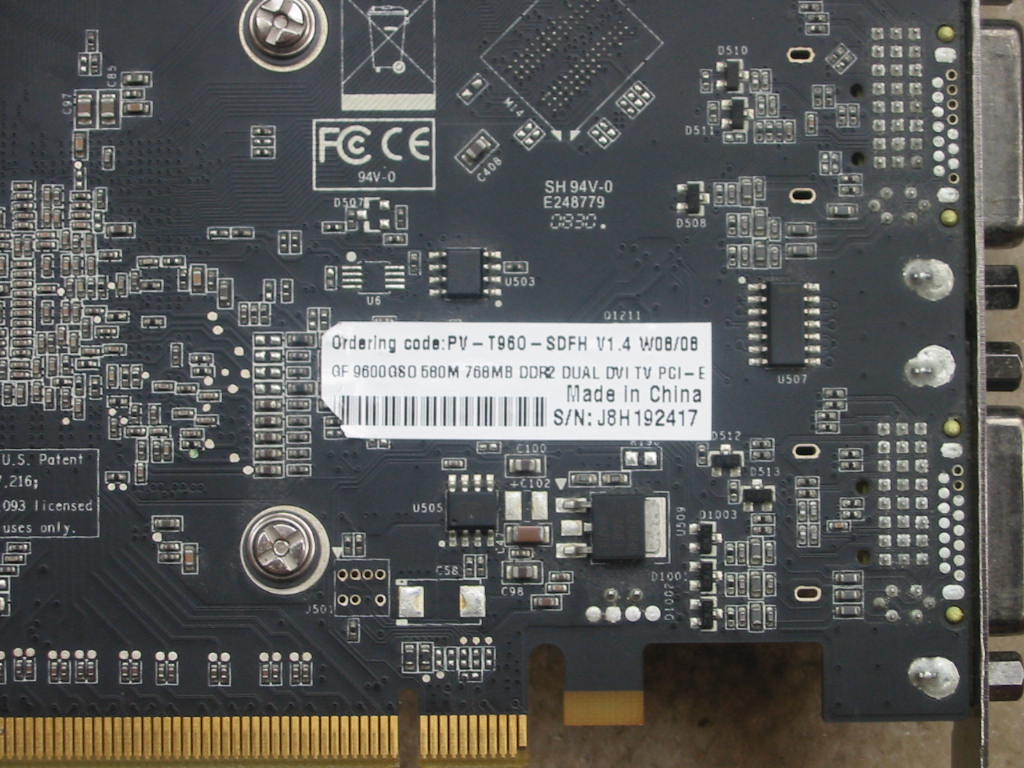
The bad boys:
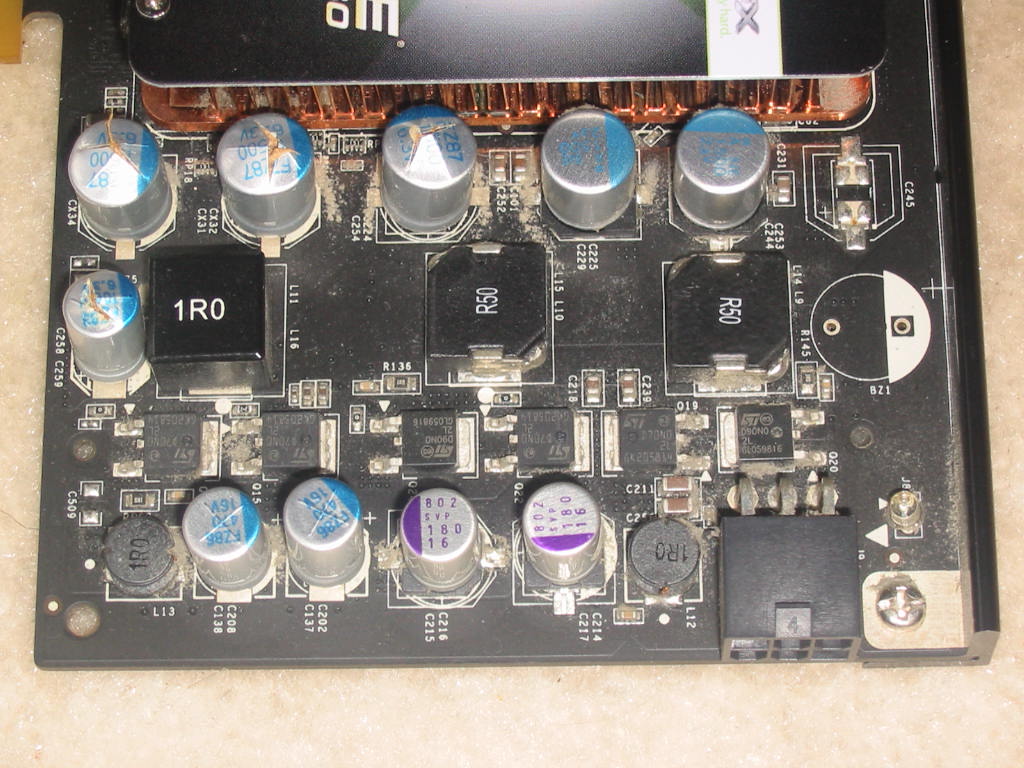
Let's see who does what – a cap diagram:
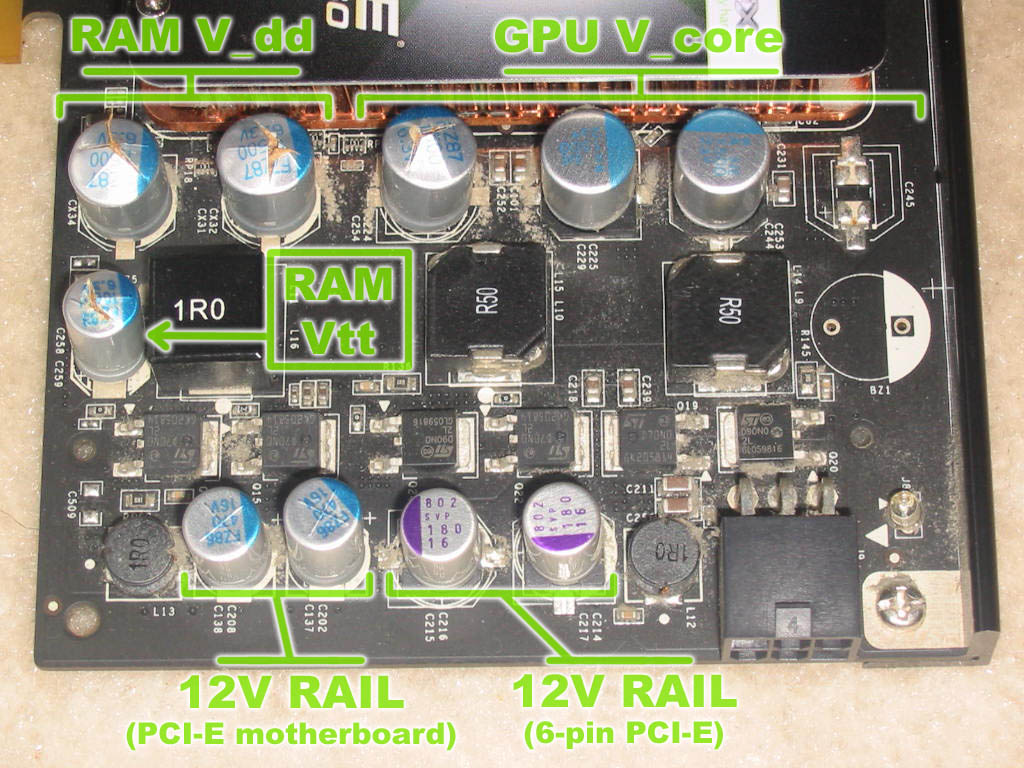
I think it should be pretty clear, but in case it's not:
…starting from the bottom (now we here? ) right corner with the 6-pin PCI-E power connector, we have 12V power directly from PSU feeding into two filter capacitors C214/C217 and C215/C216. On that note regarding the double-labeling: this is because the PCB can take either SMD or through-hole caps, with the option of 8 or 10 mm diameter – a nice feature of XFX boards, as always. Now if only XFX actually cared to use good caps in the first place…
) right corner with the 6-pin PCI-E power connector, we have 12V power directly from PSU feeding into two filter capacitors C214/C217 and C215/C216. On that note regarding the double-labeling: this is because the PCB can take either SMD or through-hole caps, with the option of 8 or 10 mm diameter – a nice feature of XFX boards, as always. Now if only XFX actually cared to use good caps in the first place…  Anyways, these two caps filter 12V power that goes to the GPU V_core buck regulator (i.e. GPU core VRM).
Anyways, these two caps filter 12V power that goes to the GPU V_core buck regulator (i.e. GPU core VRM).
Meanwhile, the two cap spots at C202/C137 and C208/C138 get 12V power from the PCI-E connector on the motherboard. The caps feed into the RAM Vdd buck regulator. Even though these caps are also connected to the 12V rail, it's worth noting that putting good caps in spots C214/C217 and C215/C216 for the GPU buck regulator will *not* provide any filtering to the RAM buck regulator high side. So having at least one good cap in spots C202/C137 or C208/C138 is required.
Moving on up, there are three caps that filter the GPU V_core rail (but spots for four caps). These are C224/C254, C225/C229, C253/C244, and empty spot C245 (SMD spot only). Only one blown Sacon FZ cap on this rail. Because of the two Chemicon PSC polymers, these 9600 GSO cards will still continue to work even with the blown FZ cap there.
To the left of the GPU VRM section/caps are the RAM filter caps: two 8/10 mm spots that hold either SMD or through-hole parts again. These are CX31/CX32 and CX34. Both of these were Sacon FZ caps on my card… and blown.
Finally, there's the RAM Vtt rail. This is derived from the RAM Vdd rail via linear regulation. Originally, this rail did not have an electrolytic filter capacitor (only the SMD ceramics on the board). But there was a spot there, so I filled it. Why? Because some “higher-end” 9600 GSO and 8800 GS models based on this PCB have a cap installed there. Thus, I figured it wouldn't hurt anything (and maybe even help with overclocking, if doing any – not that I would, though).
This being said, it is worth noting here that not all XFX 9600 GSO cards come with Sacon FZ caps. Actually, most come with Panasonic ultra-low ESR caps (not sure which series, but probably FL, FJ, or FJS judging by the pictures I've seen). And also worth noting that XFX uses this same PCB for the GeForce 8800 “GS”, which is XFX's weird spin-off of the G92 core – i.e. probably another name for the 9600 GSO. I think even some XFX 8800 GT and 9800 GT use this PCB, though I'm not 100% sure. In any case, the “better” cards typically come with Chemicon PSC polymers everywhere. On occasion, however, I've also seen them come with the Panasonic caps mentioned above. Thus, it looks like XFX use whatever parts (GPUs, RAM, and caps) they have available at the time and just re-tier the card afterwards. But when it comes to the PCB, I don't think there are many differences between the various abovementioned models, save for some fan header options perhaps (my 9600 GSO only comes with a 2-pin fan, for example).
On that note, let's talk about the cooling on this card: it's pretty LOUD. Not the most obnoxious I've heard, but annoying nevertheless. This is mainly due to the fan running at 100% all the time. On the positive side, at least this allowed the card to stay somewhat cool, even when the heatsink was fairly clogged with dust when I received it:
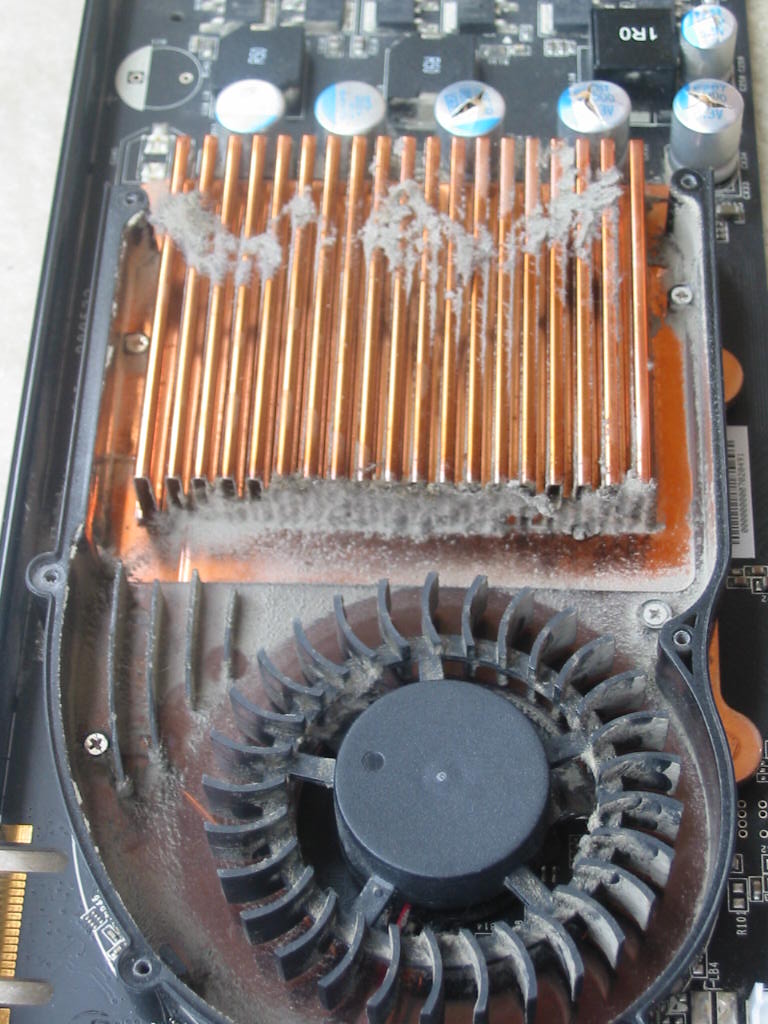
Of course, the above heatsink is not enough to keep the card under 60°C under full 100% load at normal room temperatures. But when v-sync is enabled in certain games that the card can run very well (i.e. the GPU load being no higher than 70%), the card will stay in the high 50's degrees Celsius and rarely top 60°C. Not great results again, but somewhat more acceptable, especially considering the cooler takes only a single slot. Regarding the cooler, it's all-Copper (including the fins) and fairly heavy for what it is. However, IMO the cooler could have been made to have double the fins (and hence almost double the surface area), as the fan is a fairly high-pressure squirrel-cage type with 50 mm diameter – it would have pushed air through more dense fins just fine and thus allow the card to run cooler.
And here is a shot of the heatsink from the bottom
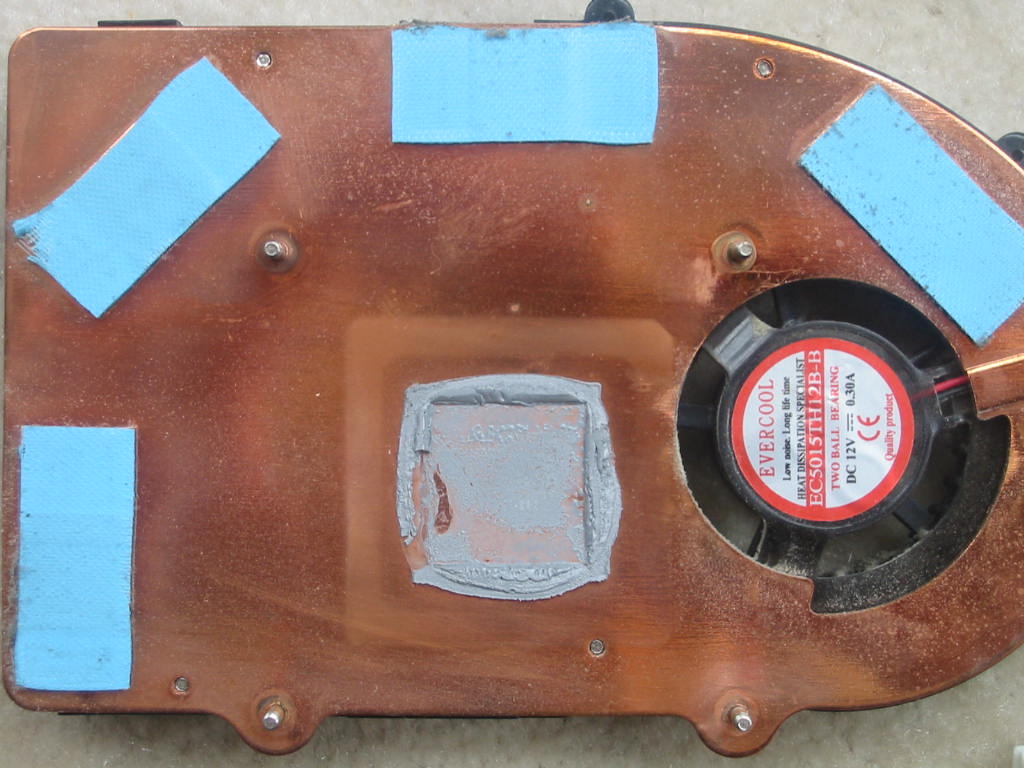
Not much to talk about here. Though I have to say I find it a bit amusing that there are 4 cooling pads for the RAM when there are only 3 sets of RAM chips on the top of the card. Again, this is probably because XFX uses the same cooler on other models of the card too, and perhaps some of them come with 4 sets of RAM chips on the top.
Finally, a picture of the temporary test recap I did:
https://www.badcaps.net/forum/attach...1&d=1543298909
The card worked, so I revised the temporary recap a bit.
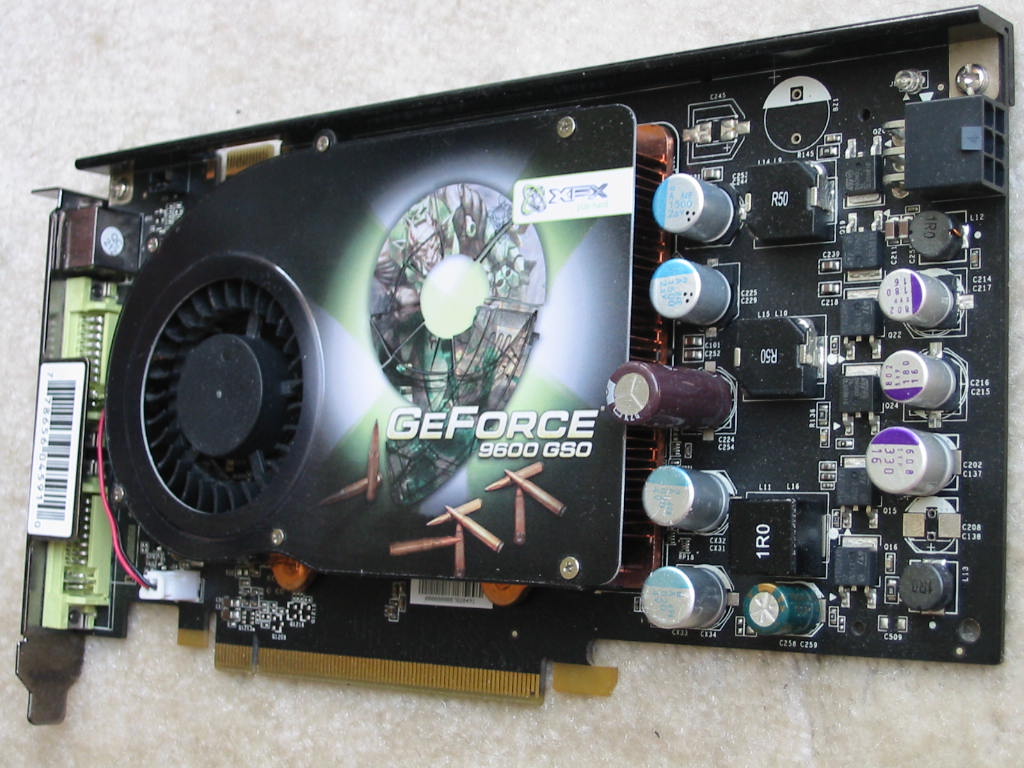
I used two Chemicon PSA 4V, 820 uF polymers (10x13 mm) from an Xbox 360 motherboard for the RAM buck filter on this card (i.e. spots CX31/CX32 and CX34). Meanwhile, the GPU V_core rail only had its lone bulged Sacon FZ cap replaced with a Chemicon KZG, 6.3V, 3300 uF cap. As can be seen in the first temporary recap, there were actually two Chemicon KZG 6.3V, 3300 uF caps (one for the RAM output filter and the other same place as it is now). Reason I did this is because the RAM showed only 2-3 Ohms resistance when I got the card with the bad FZ caps. On most cards, I find that the RAM VRM output typically reads at least 15 Ohms. Thus, I though the bad Sacon FZ caps on the RAM buck output had killed the RAM. Luckily, that wasn't the case. When I saw the card working, I replaced the lone Chemicon KZG 6.3V, 3300 uF cap on the RAM with something a “tiny bit” more reliable: the two Chemicon PSA polymers, shown above.
As for the RAM buck input (12V), I used a single Sanyo SEP, 16V, 330 uF cap from a dead (bad GPU) GeForce 7900 GS video card. And finally, the RAM Vtt rail received a lone Teapo SC, 6.3V, 1000 uF cap. Yes, I know , it's a Teapo, and SC series at that. But as I mentioned, this rail did not have a cap before, so XFX probably designed the card to work okay even without it. However, I just couldn't stand seeing that cap spot left empty. Also, I have a bag of these Teapo SC caps back from 2012 when I did a few ASUS P4SD motherboard recaps for some HP DC5000 computers. Since then, I've not yet had one of these Teapo caps fail on me, even in storage with no use. Their specs also still appear to be fairly okay on my ESR meter. So for non-critical use, I do re-use them. In this case, I was curious to see how the Teapo SC would hold up on a video card, given that it is only filtering a low-power linear rail with very little noise.
, it's a Teapo, and SC series at that. But as I mentioned, this rail did not have a cap before, so XFX probably designed the card to work okay even without it. However, I just couldn't stand seeing that cap spot left empty. Also, I have a bag of these Teapo SC caps back from 2012 when I did a few ASUS P4SD motherboard recaps for some HP DC5000 computers. Since then, I've not yet had one of these Teapo caps fail on me, even in storage with no use. Their specs also still appear to be fairly okay on my ESR meter. So for non-critical use, I do re-use them. In this case, I was curious to see how the Teapo SC would hold up on a video card, given that it is only filtering a low-power linear rail with very little noise.
Of course, if this card was going to be given to someone else, I would have recapped it properly. But being that I haven't even found a good-matching PC for it yet, it hardly gets any use. As such, I felt a bit experimental and that's why I used the Teapo SC and Chemicon KZG caps above.
Anyways, that's all I got for this card. Another one saved from the Sacon FZ curse.
I'll probably also do a cooler mod on this card at some point. But that will be later on in the future, when I find more use of the card and when I get some temperature graphs for it to see what cooler/fan combo will work best for it.
Overview front and back:
Label:
The bad boys:
Let's see who does what – a cap diagram:
I think it should be pretty clear, but in case it's not:
…starting from the bottom (now we here?
 ) right corner with the 6-pin PCI-E power connector, we have 12V power directly from PSU feeding into two filter capacitors C214/C217 and C215/C216. On that note regarding the double-labeling: this is because the PCB can take either SMD or through-hole caps, with the option of 8 or 10 mm diameter – a nice feature of XFX boards, as always. Now if only XFX actually cared to use good caps in the first place…
) right corner with the 6-pin PCI-E power connector, we have 12V power directly from PSU feeding into two filter capacitors C214/C217 and C215/C216. On that note regarding the double-labeling: this is because the PCB can take either SMD or through-hole caps, with the option of 8 or 10 mm diameter – a nice feature of XFX boards, as always. Now if only XFX actually cared to use good caps in the first place…  Anyways, these two caps filter 12V power that goes to the GPU V_core buck regulator (i.e. GPU core VRM).
Anyways, these two caps filter 12V power that goes to the GPU V_core buck regulator (i.e. GPU core VRM).Meanwhile, the two cap spots at C202/C137 and C208/C138 get 12V power from the PCI-E connector on the motherboard. The caps feed into the RAM Vdd buck regulator. Even though these caps are also connected to the 12V rail, it's worth noting that putting good caps in spots C214/C217 and C215/C216 for the GPU buck regulator will *not* provide any filtering to the RAM buck regulator high side. So having at least one good cap in spots C202/C137 or C208/C138 is required.
Moving on up, there are three caps that filter the GPU V_core rail (but spots for four caps). These are C224/C254, C225/C229, C253/C244, and empty spot C245 (SMD spot only). Only one blown Sacon FZ cap on this rail. Because of the two Chemicon PSC polymers, these 9600 GSO cards will still continue to work even with the blown FZ cap there.
To the left of the GPU VRM section/caps are the RAM filter caps: two 8/10 mm spots that hold either SMD or through-hole parts again. These are CX31/CX32 and CX34. Both of these were Sacon FZ caps on my card… and blown.
Finally, there's the RAM Vtt rail. This is derived from the RAM Vdd rail via linear regulation. Originally, this rail did not have an electrolytic filter capacitor (only the SMD ceramics on the board). But there was a spot there, so I filled it. Why? Because some “higher-end” 9600 GSO and 8800 GS models based on this PCB have a cap installed there. Thus, I figured it wouldn't hurt anything (and maybe even help with overclocking, if doing any – not that I would, though).
This being said, it is worth noting here that not all XFX 9600 GSO cards come with Sacon FZ caps. Actually, most come with Panasonic ultra-low ESR caps (not sure which series, but probably FL, FJ, or FJS judging by the pictures I've seen). And also worth noting that XFX uses this same PCB for the GeForce 8800 “GS”, which is XFX's weird spin-off of the G92 core – i.e. probably another name for the 9600 GSO. I think even some XFX 8800 GT and 9800 GT use this PCB, though I'm not 100% sure. In any case, the “better” cards typically come with Chemicon PSC polymers everywhere. On occasion, however, I've also seen them come with the Panasonic caps mentioned above. Thus, it looks like XFX use whatever parts (GPUs, RAM, and caps) they have available at the time and just re-tier the card afterwards. But when it comes to the PCB, I don't think there are many differences between the various abovementioned models, save for some fan header options perhaps (my 9600 GSO only comes with a 2-pin fan, for example).
On that note, let's talk about the cooling on this card: it's pretty LOUD. Not the most obnoxious I've heard, but annoying nevertheless. This is mainly due to the fan running at 100% all the time. On the positive side, at least this allowed the card to stay somewhat cool, even when the heatsink was fairly clogged with dust when I received it:
Of course, the above heatsink is not enough to keep the card under 60°C under full 100% load at normal room temperatures. But when v-sync is enabled in certain games that the card can run very well (i.e. the GPU load being no higher than 70%), the card will stay in the high 50's degrees Celsius and rarely top 60°C. Not great results again, but somewhat more acceptable, especially considering the cooler takes only a single slot. Regarding the cooler, it's all-Copper (including the fins) and fairly heavy for what it is. However, IMO the cooler could have been made to have double the fins (and hence almost double the surface area), as the fan is a fairly high-pressure squirrel-cage type with 50 mm diameter – it would have pushed air through more dense fins just fine and thus allow the card to run cooler.
And here is a shot of the heatsink from the bottom
Not much to talk about here. Though I have to say I find it a bit amusing that there are 4 cooling pads for the RAM when there are only 3 sets of RAM chips on the top of the card. Again, this is probably because XFX uses the same cooler on other models of the card too, and perhaps some of them come with 4 sets of RAM chips on the top.
Finally, a picture of the temporary test recap I did:
https://www.badcaps.net/forum/attach...1&d=1543298909
The card worked, so I revised the temporary recap a bit.
I used two Chemicon PSA 4V, 820 uF polymers (10x13 mm) from an Xbox 360 motherboard for the RAM buck filter on this card (i.e. spots CX31/CX32 and CX34). Meanwhile, the GPU V_core rail only had its lone bulged Sacon FZ cap replaced with a Chemicon KZG, 6.3V, 3300 uF cap. As can be seen in the first temporary recap, there were actually two Chemicon KZG 6.3V, 3300 uF caps (one for the RAM output filter and the other same place as it is now). Reason I did this is because the RAM showed only 2-3 Ohms resistance when I got the card with the bad FZ caps. On most cards, I find that the RAM VRM output typically reads at least 15 Ohms. Thus, I though the bad Sacon FZ caps on the RAM buck output had killed the RAM. Luckily, that wasn't the case. When I saw the card working, I replaced the lone Chemicon KZG 6.3V, 3300 uF cap on the RAM with something a “tiny bit” more reliable: the two Chemicon PSA polymers, shown above.
As for the RAM buck input (12V), I used a single Sanyo SEP, 16V, 330 uF cap from a dead (bad GPU) GeForce 7900 GS video card. And finally, the RAM Vtt rail received a lone Teapo SC, 6.3V, 1000 uF cap. Yes, I know
 , it's a Teapo, and SC series at that. But as I mentioned, this rail did not have a cap before, so XFX probably designed the card to work okay even without it. However, I just couldn't stand seeing that cap spot left empty. Also, I have a bag of these Teapo SC caps back from 2012 when I did a few ASUS P4SD motherboard recaps for some HP DC5000 computers. Since then, I've not yet had one of these Teapo caps fail on me, even in storage with no use. Their specs also still appear to be fairly okay on my ESR meter. So for non-critical use, I do re-use them. In this case, I was curious to see how the Teapo SC would hold up on a video card, given that it is only filtering a low-power linear rail with very little noise.
, it's a Teapo, and SC series at that. But as I mentioned, this rail did not have a cap before, so XFX probably designed the card to work okay even without it. However, I just couldn't stand seeing that cap spot left empty. Also, I have a bag of these Teapo SC caps back from 2012 when I did a few ASUS P4SD motherboard recaps for some HP DC5000 computers. Since then, I've not yet had one of these Teapo caps fail on me, even in storage with no use. Their specs also still appear to be fairly okay on my ESR meter. So for non-critical use, I do re-use them. In this case, I was curious to see how the Teapo SC would hold up on a video card, given that it is only filtering a low-power linear rail with very little noise.Of course, if this card was going to be given to someone else, I would have recapped it properly. But being that I haven't even found a good-matching PC for it yet, it hardly gets any use. As such, I felt a bit experimental and that's why I used the Teapo SC and Chemicon KZG caps above.
Anyways, that's all I got for this card. Another one saved from the Sacon FZ curse.
I'll probably also do a cooler mod on this card at some point. But that will be later on in the future, when I find more use of the card and when I get some temperature graphs for it to see what cooler/fan combo will work best for it.

 (unless it was manufactured after 2007)
(unless it was manufactured after 2007) 

Comment